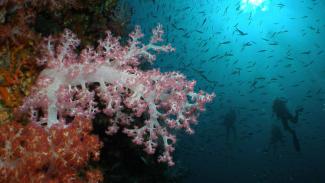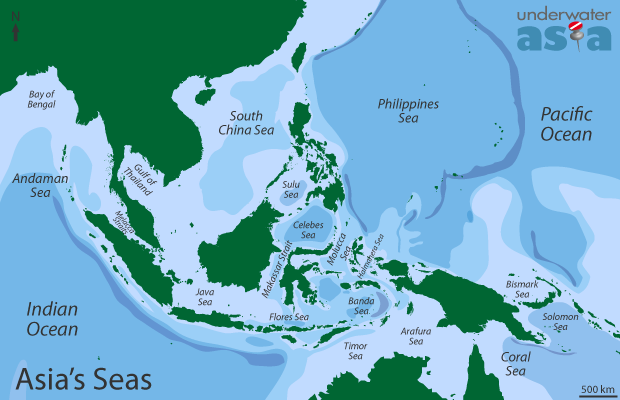The seas of Asia

Asia is caught between two huge oceans, the Indian Ocean to the west and the Pacific to the east. In between is a complex geography of land & water that has given rise to some of the most fascinating & species rich seas on our planet.
Much of the geography of south-east Asia is dictated by the Pacific Ring of Fire, a geologically active zone around the edges of the Pacific, that encompasses the region and shapes the landscape producing volcanoes, mountains, island chains & trenches.
This complex geography has also produced 15 unique seas and many straits, which between them comprise the most complex & diverse eco-system on the planet.
From ocean to ocean
Starting to the west, the Andaman Sea sits between the Indian Ocean & the coasts of Burma, Thailand, Malaysia & Indonesia, drifting into the Bay of Bengal in the north. Its western perimeter is marked by the remote Andaman Island chain. The Similans, Mergui Archipelago & Pulah Weh are some of the great diving spots in the Andaman.
Thailand, Peninsular Malaysia & the giant Indonesian island of Sumatra separate the Andaman Sea from the South China Sea, the largest in Asia. This sea stretches across to the Philippines in the east, laps the shores of Borneo to the south, and Vietnam & China to the north.
The South China Sea comes to a head in the shallow Gulf of Thailand. This is one of the few parts of Asia where the flow of water is slow, meaning the water is not as rich in nutrients as other seas in the region.
To the east, the sea increases in depth as it reaches the Philippines, giving rise to some spectacular dive spots, such as Layang Layang & the sites of northern Palawan.
Separated from the South China Sea by the island of Palawan is the Sulu Sea. The Sulu Sea is one of the smallest, but most productive of Asia’s seas. The Sulu Sea marks the northern tip of the now famous Coral Triangle, the most biologically diverse marine region on earth. It reaches northern Borneo to the south and the islands of the Visayas & Mandanao in the Philippines to the east.
The Sulu Sea is deep, bringing nutrient rich upwellings from great depths that support the spectacular congregations of marine life found at sites such as Sipadan & the remote Tubbataha Reefs. The popular dive sites of the Visayas region also fall within the Sulu Sea.
To the east, the Philippines Sea reaches out to the Pacific Ocean. Here, where the Pacific techtonic plate disappears below the Philippine plate, the sea plunges to the greatest depths on the planet. This trench is known as the Mariana trench, reaching a staggering depth of 10.9 km.


Tara North

Phil North

